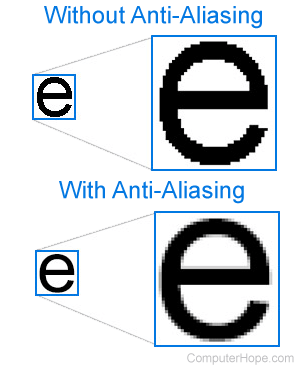Anti-aliasing
Anti-aliasing may refer to any of the following:

1. Sometimes abbreviated as AA, anti-aliasing describes the software process of making the edges of graphics objects or fonts smoother. Accomplished by adding additional pixels in-between the edges of an object and its background. Anti-aliasing improves the appearance of polygon edges, so they are not "jagged" but are smoothed out on the screen.
In the example image, we show a zoomed and non-zoomed 'e' without antialiasing (top) and with anti-aliasing (bottom). As shown in the top example, the edges appear to be jagged without antialiasing when using a bitmap font. Programs that support text antialiasing have an option that can be checked or selected to enable antialiasing.
2. An AA filter or anti-aliasing filter is a filter used before a signal sampler, to restrict the bandwidth of a signal to approximately satisfy the sampling theorem. In the case of optical image sampling, as by image sensors in digital cameras, the anti-aliasing filter is also known as an AA filter, blur filter, or optical low-pass filter.
The AA filter removes information that cannot be recorded "correctly" by the sensor. It is an extra layer on top of the sensor that reduces the image quality to remove certain undesired artifacts. If you remove the AA filter, the drawback is that you can get moire patterns in certain situations.
AA, Alias, Bitmap font, Computer acronyms, Display terms, Font, Pixel, Pixelated, Typography terms
